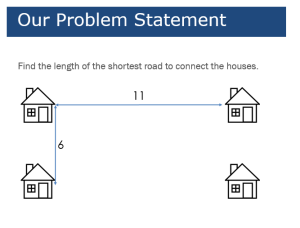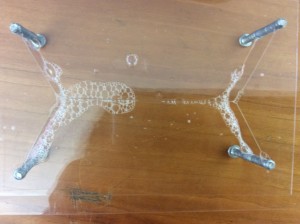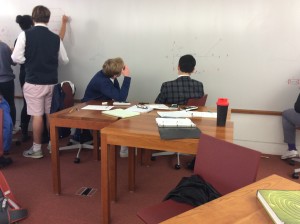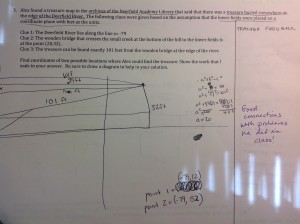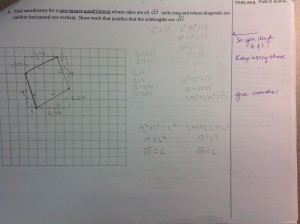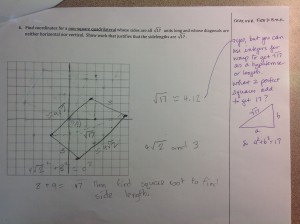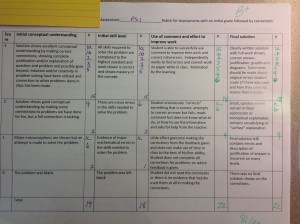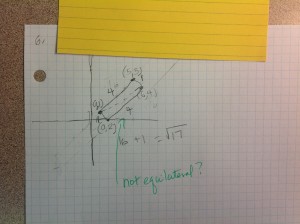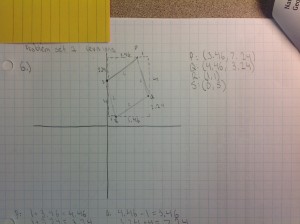I was totally honored the other day when I saw some tweets from TMC16 from @0mod3 and @Borschtwithanna
And yes it’s true, I’ve been writing and practicing the use of metacognitive journaling for very long time – probably since 1996 ever since I read Joan Countryman’s book about mathematical journaling and heard about it in many workshops that summer. I wrote a rubric (make sure you scroll to the 3rd page) while I was at the Klingenstein Summer Institute for New Teachers (that’s how long ago it was) and since then I’ve been refining that rubric based on feedback from students and teachers. A few years ago, I finally refined a document called How to Keep a Journal for Math Class to a degree that I really like it now. However, please know that lots of math teachers do journaling differently and without the metacognitive twist. I do believe that metacognitive writing is essential to the PBL classroom (read more here)
So this morning, I was asked this question on twitter
Which is something that many people often ask so I thought I’d respond with a more in-depth answer.
Here are the pros, I’ve found over the years of having students journal digitally:
Speed/complexity: Students are used to typing, using spell-check, inserting pictures, graphics and naturally including documents, links and thinking in the complex way that digital media allows them to. It allows their journal to be more rich in content and sometimes connect problems to each other if their journal is say on a google doc that can connect to other html docs. If they create, for example, iBooks or Explain Everything videos, there is even a lot more richness that can be embedded in the file as well – their creativity is endless.
Grading/Feedback: I found grading in Notability or on Google docs or some other digital platform really nice that allowed you to add comments with a click or audio extremely easy and quick. I did not receive feedback from the students very often about how the feedback helped them though. If you use an LMS like Canvas that integrates a rubric or integrates connection to Google it’s even nicer because you can have those grades go right from your assignment book to your gradebook.
I love having kids use digital platforms for writing/creating in mathematics when it is for a project or big problem that I want them to include many pieces of evidence, graphs, geogebra files and put it together nicely in a presentation or portfolio. Not necessarily for their biweekly journals. Some guys who make use of digital journals in interesting ways are @GibsonEdu and @FrasiermathPBL at the Khabele School in Austin TX.
Here are the cons, in my mind of using digital journals: (which might be the “pros” of paper journals) – which is the side I have come down on.
the “real” writing factor: there is some research about the actual physical process of writing and the time it takes for kids to process their thoughts. I do believe that when i want kids to be metacognitive about their learning and also want them to be thoughtful and take the time think about their initial error, think about what happened in class discussion to clear up their misunderstanding and also then what new understanding they came to. That’s a lot of thinking. So I want them to take the time to write all that down. Sometimes typing (like what I’m doing right now!) is a fast process and I’m not sure I do my best writing this way.
practice in hand-writing problem solving: this is re-enacting doing homework and sitting for assessments (in my class at least) and I want them to do this more regularly. If in your class kids take assessments digitally or do homework nightly digitally then maybe they should do their journal digitally as well. This also give me practice in reading their handwriting, getting to hear their voice through their handwriting and seeing what it looks like on a regular basis. In a time crunch on an assessment it honestly helps me know what they are thinking.
Conversational Feedback: I feel that when I hand write my feedback to them I can draw a smilely face or arrows or circle something that I want to emphasize more easily than when it is on something digitally (this is also true in a digital ink program – so that is something to consider, like Notability for example). I give feedback (see some journal examples on my blog) that is very specific about their writing and want the to improve not only in the math aspect of their writing but in how they are looking at their learning. I want them to respond and I want to respond in the hope that we are starting a mathematical conversation about the problem. I have received more questions about the feedback in the paper journals (like “what did you mean by this?”) than on the electronic feedback – not sure why.
Portability: I find that small composition graph paper notebook is extremely portable and easy for me to carry home to grade. The students bring them to their assessments and there is nothing else in the notebook (no homework at all and no access to the internet) so I am not worried about academic honestly.
There are probably more but this is it in a nutshell – please add your comments below or tweet me to let me know your thoughts!
